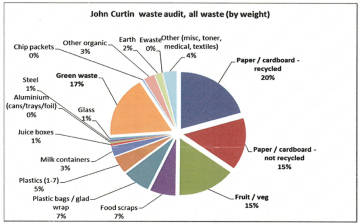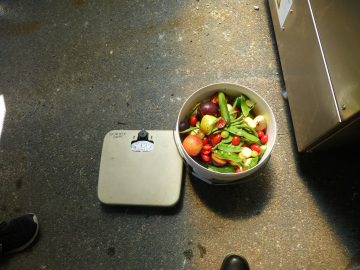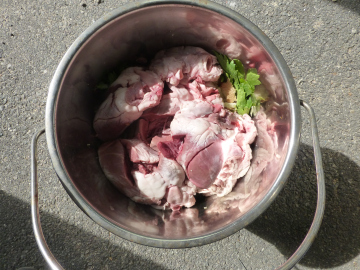Electric composters to reduce waste in schools
John Curtin College of the Arts caters for over 1900 students and has implemented the Waste Wise Schools (WWS) program since 2012. A waste audit conducted in 2015 showed that food waste made up 23 per cent of the college’s total waste.
One week’s waste, by weight (per cent), John Curtin College of the Arts

Following the waste audit, the WWS program investigated food waste processing solutions for high schools, including a food waste collection service and an electric composter.
Electronic composter trial
In 2016, John Curtin College was selected to trial an electric composter. They trialled a ‘CLO-10’ electronic composer from Closed Loop. The electric composter is about the size of a large chest freezer and processes 20kg of food waste per day. It uses heat (dehydration), churning and a bacterial component to reduce the volume of food waste by up to 90 per cent within 24 hours. It produces a compost which is harvested each week.
In 2019, the school prevented almost 2000kg of food waste from going to landfill.
An electric composter was chosen because it could process fruit and vegetable scraps as well as other food waste not suitable for other composting methods, such as dairy, bread and meat products.
The composter could also be used on-site as a soil conditioner, which was a bonus because the college sits on a limestone ridge, which means the soil is very poor.
Step 1: find a location
Setting up a successful waste collection system in a school requires planning for infrastructure, collection systems and allocation of staff and student responsibilities. Educating those who will be using the system is also vital to preventing contamination.
Electronic composters need to be kept in a dry place with access to power. The college purchased a small lockable shed with windows and an exhaust fan for ventilation. The shed was placed in an area usually out of bounds to students to reduce student traffic. Initially there were concerns about the smell produced by the electronic composter; however, this was found to be minimal, with some staff reporting it actually smelled pleasant, ‘like a hearty beef stock’.
Step 2: collect the organic waste
John Curtin College trialled different types of collection bins.
- white 20 litre buckets with lids were used for the canteen, student eating areas and staff room
- kitchen caddies (9 litres) were used in food technology classes (and emptied into white buckets)
- metal buckets were purchased for science dissection scraps, so that the buckets could be disinfected (animal dissection scraps can be composted too!).

Food waste buckets were collected and cleaned every day to deter vermin. Collection was done by the ground staff who would be using the compost on the school grounds. Food waste was collected and loaded into the composter each day after lunch.

Step 3: School engagement
Engaging staff and students is essential to achieving behaviour change. A group of staff were trained in using the electric composters. Members of the school’s Sustainability Committee spoke at whole school staff and individual department meetings to inform staff of the trial and how they could provide support. The school community was kept informed with regular articles in the newsletter, school notices and posts on social media.
The Roots and Shoots student sustainability group named the composter ‘Audrey’, after the school’s 2016 performance, Little Shop of Horrors. The story features a carnivorous plant puppet called Audrey II, whose catchphrase is ‘feed me’. The students therefore thought ‘Audrey’ was an apt name for a machine that always requires food.
The Roots and Shoots student sustainability group named the composter ‘Audrey’, after the school’s 2016 performance, Little Shop of Horrors. The story features a carnivorous plant puppet called Audrey II, whose catchphrase is ‘feed me’. The students therefore thought ‘Audrey’ was an apt name for a machine that always requires food.

Roots and Shoots 2019 sustainability group members with the electronic composter and Audrey II puppet from the 2016 performance of Little Shop of Horrors. Photos: Jeremy Wheaton

Electric composter – success
In 2019, 1970kg of food waste was processed in the electronic composter. That is nearly two metric tons, or 12 skip bins. This represents a significant reduction in waste sent to landfill, saving money on waste removal costs as well as on buying compost for the grounds.
The canteen was the biggest contributor with 600kg of organic waste collected, followed by food technologies with 495kg and the Year 7 students with 197kg, almost twice the amount as that collected by the Year 8 and 9 students.
The Year 7 students may have collected more food waste because:
- they were the first group of students to be involved in the trial
- they were involved in similar food waste collection systems at primary school
- many of them belong to the school’s sustainability group
- they received excellent education at the point of collection from the duty (supervision) teachers, several of whom were on the Sustainability Committee
- they anthropomorphised the electronic composter, naming it ‘Audrey’, so they (and the broader college community) became attached to it and felt they needed to keep ‘her’ fed.
As the trial progressed, there was an increase in the overall collection of organic waste indicating a change in behaviour towards the collection of food scarps and organic waste.
After presenting the findings of the electronic composter trial to the school executive, and with the help of a Waste Wise Schools grant, the college purchased the composter to keep for long-term use.
Is an electric composter right for your school?
There are many options for processing food waste in schools, such as:
- wormfarming
- composting
- food waste collection services (e.g. wheelie bins)
- electric composters.
Schools with a large student population may find an electric composter suitable, particularly if there is a large volume of food waste generated in the canteen and food technology classes. An electric composter is also suitable for schools wishing to process all food scraps, including dairy, meat and bread.
Schools report that it is essential to establish a good system to collect food waste, regardless of the chosen system. Many high schools find composting is more successful if managed by staff (such as the grounds staff).
Advantages and disadvantages of using an electronic composter system
| Advantages | Disadvantages |
|---|---|
|
Processes large amounts of food waste and reduces waste to landfill (up to 100kg per week). Food waste makes up about 23 per cent of the school’s waste stream. |
Requires a significant initial capital outlay, which can be offset by future waste management reduction costs. |
| Can process dairy, meat, bread and small bones. Most other compost processes cannot compost these | Requires electricity, a dry area and ventilation (e.g. exhaust fan). |
| Easy to use. | Needs space, both for the machine and storage of compost. |
| Hygienic and minimal smell. | Machine will automatically shut down if the wrong materials are placed inside (e.g. plastic bags can entangle in the mixing paddles). |
| Fast compost time (24 hours) | Compost needs to removed weekly |
| Saves money on waste collection. | Like other composting systems, it requires staff support (e.g. having grounds staff willing to collect food waste and load the composter). |
| Saves money buying compost and soil additives. | |
| Improves gardens by using compost. |
Sincere thanks to John Curtin College of the Arts for taking part in the research, and to Ms Peta Scorer, teacher, for preparing this case study.
If you have any questions or queries about using electronic composters, please contact Waste Wise Schools at wastewise@dwer.wa.gov.au


